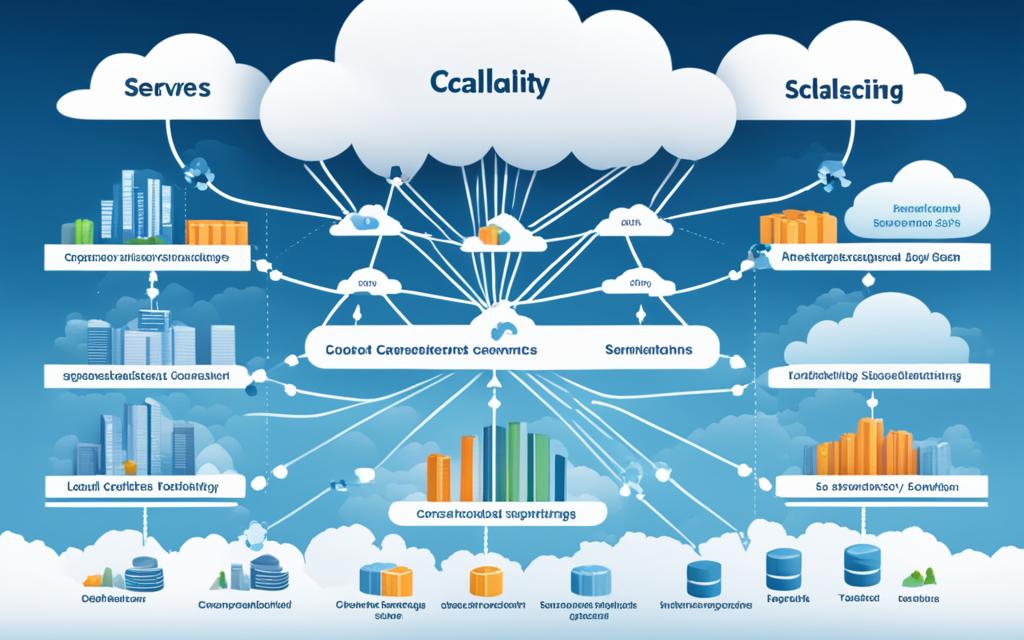Welcome to the world of cloud computing, where businesses have the flexibility to scale their resources up or down to meet their ever-changing needs. In this rapidly evolving digital landscape, cloud scalability has become a critical factor for success.
Cloud scalability refers to the ability of cloud-hosted environments to handle increased traffic without compromising performance. It enables businesses to efficiently handle peak loads while also optimizing costs during quieter periods. When it comes to designing a scalable cloud architecture, it’s essential to prioritize scalability from the outset to avoid costly infrastructure redesigns as your business grows.
Building a scalable cloud architecture offers numerous advantages, including cost efficiency, reliability, and security. By effectively employing different types of scaling techniques such as vertical, horizontal, and diagonal scaling, businesses can ensure their infrastructure can handle increased traffic. Amazon Web Services (AWS) offers a range of services, including ASG, ECS, EKS, S3, RDS, and CloudWatch, that can help you build a robust and scalable computing environment.
In this article, we will explore the concept of cloud scalability in more detail, discuss strategies for building scalable cloud architectures, delve into network scalability and design principles, and explore network scaling strategies and technologies. By the end of this article, you’ll have a comprehensive understanding of how to design and implement scalable cloud network architectures using best practices and cutting-edge technologies.
Stay tuned to discover the key principles and strategies for achieving seamless cloud scalability and designing architectures that can evolve with your business.
What is Cloud Scalability?
Cloud scalability is a fundamental concept in cloud computing that enables cloud-hosted environments to efficiently handle changing workloads without compromising performance. It refers to the ability of a system to scale its capacity up or down based on demand, ensuring optimal resource allocation and cost efficiency.
Cloud scalability can be achieved through various types of scaling, including:
- Vertical scaling: This involves increasing the resources allocated to a single instance within the cloud environment. It includes scaling up CPU, memory, or disk capacity to improve the performance of individual instances. Vertical scaling is often accomplished by upgrading the hardware specifications of the instance.
- Horizontal scaling: Unlike vertical scaling, horizontal scaling focuses on adding more instances to the cloud environment to distribute the workload. By increasing the number of instances, the overall capacity and performance of the system can be expanded. Horizontal scaling is particularly effective for distributing large workloads.
- Diagonal scaling: Diagonal scaling combines both vertical and horizontal scaling approaches. It involves increasing the resources allocated to each instance and simultaneously adding more instances to the environment. This approach offers a balanced solution for both resource allocation and workload distribution.
Implementing scalable cloud architecture from the outset is crucial to avoid the need for infrastructure redesign in the future. By designing and developing a scalable solution at the initial stages of cloud deployment, businesses can effectively accommodate growth and ensure a seamless user experience.
“Cloud scalability allows businesses to adapt and respond to changing demands without disrupting operations or incurring additional costs.”
| Scaling Type | Description |
|---|---|
| Vertical Scaling | Increases resources allocated to individual instances by scaling up CPU, memory, or disk capacity. |
| Horizontal Scaling | Adds more instances to the cloud environment to distribute the workload and improve overall capacity. |
| Diagonal Scaling | Combines vertical and horizontal scaling approaches by increasing resources allocated to each instance and adding more instances to the environment. |
Building Scalable Cloud Architecture
Building a scalable cloud architecture requires careful planning and consideration of various factors. By following best practices and utilizing key technologies, businesses can create a robust and scalable infrastructure that can adapt to changing demands. Here are some essential considerations for building a scalable cloud architecture:
- Modular Design: Start with a modular design approach, breaking down complex components into smaller, manageable parts. This modular approach, such as using microservices, makes scaling, securing, and managing the application easier.
- Containerization: Leverage containerization technologies like Docker or Kubernetes to further simplify scalability. Containerization allows for the efficient deployment and scaling of application components, making the application more agile and easier to manage.
- Statelessness and Lightweight App Image: Make the application stateless and keep the app image lightweight. This enables faster scaling and reduces the impact on resources, allowing for better performance during peak loads.
- Reliability: Ensure reliability by utilizing highly available cloud services that offer cross-region replication. Distributing resources across multiple regions helps to mitigate the risk of downtime and enhances the overall reliability of the architecture.
- Monitoring and Data-Driven Scaling: Monitor key infrastructure parameters and create alerts for abnormal states. This data-driven approach enables proactive scaling decisions based on real-time insights, optimizing resource allocation and maximizing performance.
- Automation: Embrace automation in the form of autoscaling and continuous integration and continuous delivery (CICD) pipelines. Automation streamlines the scaling process, allowing for quick and seamless adjustments based on demand fluctuations.
- Security: Prioritize security from the start by leveraging the built-in security features provided by cloud computing vendors. Implement robust security measures to protect sensitive data and ensure compliance with industry regulations.
By implementing a scalable cloud architecture with a modular design, containerization, reliability mechanisms, monitoring, automation, and robust security measures, businesses can create an infrastructure that can effectively handle increased workloads and scale to meet future demands.

Network Scalability and Design Principles
Network scalability is a critical aspect of designing a robust and efficient network architecture. It refers to the network’s ability to handle increasing loads without compromising its quality of service. When building a scalable network, network engineers must consider various scalability metrics, including throughput, latency, availability, and resilience.
One fundamental principle of network design is modularity. By dividing the network into smaller, reusable units, modularity allows for easier expansion, modification, and troubleshooting. Each modular unit can be independently scaled, ensuring flexibility and adaptability as the network grows.
Another important design principle in network scalability is abstraction. Abstraction involves hiding the complexity of the network from users and applications, simplifying communication and interaction between different network layers and components. This abstraction layer enables efficient scalability and promotes seamless integration of new technologies and services.
“Modularity and abstraction are essential design principles that lay the foundation for a scalable and adaptable network architecture.”
By following these design principles of modularity and abstraction, network scalability can be achieved effectively, ensuring optimal performance and flexibility for future growth.
To illustrate the importance of these design principles, let’s take a look at a hypothetical scenario:
Hypothetical Scenario: Building a Scalable Network Architecture
XYZ Corporation is a rapidly growing technology company that requires a scalable network architecture to support its expanding user base and increasing data traffic. The network architects at XYZ Corporation decide to implement a modular design, dividing the network into smaller, reusable units.
They start by breaking down the network into separate segments, such as the core network, distribution network, and access network. Each segment is designed to handle specific tasks and can be independently scaled as needed.
The core network, for example, is responsible for high-speed data transmission between different segments of the network. By designing it as a separate module, the network architects can easily scale its capacity and throughput without impacting other network components.
The distribution network, on the other hand, handles the traffic between the core network and the access network. By implementing modularity, the network engineers can easily expand the distribution network by adding more switches or routers, ensuring smooth traffic flow even as the user base grows.
The access network is responsible for connecting end-user devices, such as computers and mobile devices, to the network. By using modular access points, the network architects can easily add or remove access points as needed, accommodating increased demand and ensuring uninterrupted connectivity for users.
Furthermore, the network architects apply the principle of abstraction by implementing network protocols and addressing schemes that hide the underlying network complexity from end-users and applications. This abstraction layer allows for seamless communication and interaction, promoting network efficiency and scalability.
Overall, the adoption of modularity and abstraction ensures that XYZ Corporation’s network architecture is scalable, adaptable, and capable of handling future growth and evolving technology requirements.
| Benefits of Network Scalability and Design Principles | Key Considerations |
|---|---|
|
|
Network Scaling Strategies and Technologies
Network scaling plays a vital role in ensuring the efficient handling of increasing workloads and maintaining optimal network performance. There are several strategies and technologies that can be employed to achieve network scalability, including vertical scaling, horizontal scaling, load balancing, database scaling, cloud services, containerization, and network virtualization.
Vertical Scaling
Vertical scaling involves increasing the capacity and performance of a single network device. This can be done by upgrading the hardware components of the device, such as adding more memory, increasing processing power, or expanding storage capacity. Vertical scaling is an effective way to handle increased traffic and ensure that the network device can cope with growing demands.
Horizontal Scaling
Horizontal scaling focuses on adding more devices to the network to handle increased workloads. By distributing the network traffic across multiple servers or devices, horizontal scaling improves performance and enhances network reliability. This is achieved through the use of load balancers, which evenly distribute incoming requests among the network devices, preventing any single device from being overwhelmed. Load balancing is a crucial technique for achieving scalability in network architectures.
Database Scaling
As data grows, database scaling becomes essential to ensure efficient data storage and retrieval. Sharding and replication are common strategies used for database scaling. Sharding involves partitioning a database into smaller, more manageable parts, distributing the data across multiple servers. This allows for improved performance and increased capacity. Replication involves maintaining copies of the database across multiple servers, ensuring data redundancy and high availability. Both sharding and replication contribute to effective database scaling.
Cloud Services
Cloud services, such as Amazon Web Services (AWS), Microsoft Azure, and Google Cloud, offer scalable infrastructure and resources. Leveraging cloud services allows for flexible scaling based on demand. With cloud services, organizations can easily add or remove network devices, adjust resource allocations, and scale their infrastructure as needed. Cloud services provide a cost-effective and scalable solution for network scaling.
Containerization
Containerization technology, exemplified by tools like Docker, enables efficient scaling and resource utilization. Containers provide an isolated environment for running applications, allowing for easy deployment, scalability, and portability. By containerizing network services and applications, organizations can scale their network infrastructure quickly and efficiently.
Network Virtualization
Network virtualization, such as Software-Defined Networking (SDN), abstracts the underlying network infrastructure, allowing for flexible and dynamic network scaling. With network virtualization, network resources can be provisioned and managed programmatically, simplifying network administration and enabling efficient scaling. SDN separates the control plane from the data plane, providing centralized control and enabling network scalability.
| Strategy/Technology | Description |
|---|---|
| Vertical Scaling | Increasing the capacity and performance of a single network device. |
| Horizontal Scaling | Adding more devices to the network to handle increased workloads and improve performance. |
| Load Balancing | Distributing network traffic across multiple servers or devices to optimize performance and reliability. |
| Database Scaling | Implementing strategies like sharding and replication to handle growing data. |
| Cloud Services | Utilizing scalable infrastructure and resources offered by cloud providers. |
| Containerization | Using containerization technology to enable efficient scaling and resource utilization. |
| Network Virtualization | Abstracting the underlying network infrastructure to enable flexible and dynamic network scaling. |
Conclusion
Scalable architectures play a crucial role in accommodating growth and ensuring optimal performance for businesses. By adopting microservices architecture, load balancing techniques, and efficient database scaling, organizations can lay a strong foundation for scalable architectures. Leveraging cloud services, containerization, and network virtualization further enhances the ability to scale resources efficiently.
Following best practices is essential in building scalable architectures. Continuous monitoring and implementing effective scaling strategies allow businesses to respond to changing demands. Furthermore, assessing current and future needs, testing and validating scalability, and thoroughly documenting the network architecture lay the groundwork for a robust and future-proof system.
By embracing these principles and utilizing modern tools and technologies, engineers can create scalable architectures that can handle rapid growth and withstand the test of time. Scalable architectures are not just about managing growth but also optimizing performance, ensuring availability, and enhancing security. With the right approach and careful implementation, businesses can achieve seamless scalability and stay ahead in the competitive landscape.
FAQ
What is cloud scalability?
Cloud scalability refers to the ability of cloud-hosted environments to increase or decrease their capacity to handle changing workloads. It ensures that the system’s performance does not drop even as loads grow.
Why is building scalable cloud architecture important?
Building a scalable cloud architecture has multiple advantages, including cost efficiency, reliability, and security. Implementing scalable cloud architecture from the outset is crucial to avoid the need for infrastructure redesign in the future.
What considerations are important when building a scalable cloud architecture?
Important considerations when building a scalable cloud architecture include starting with a modular design, implementing containerization, making the application stateless, ensuring reliability through cross-region replication, monitoring infrastructure parameters, and automating scaling processes.
What is network scalability?
Network scalability refers to a network’s ability to handle increasing loads without compromising its quality of service. It involves considering scalability metrics like throughput, latency, availability, and resilience when designing a scalable network architecture.
What design principles are important for network scalability?
Modularity and abstraction are important design principles for network scalability. Modularity involves dividing the network into smaller, reusable units, while abstraction hides the complexity of the network from users and applications.
What strategies and technologies can be used for network scaling?
Network scaling can be achieved through vertical scaling (increasing the capacity and performance of a single network device) and horizontal scaling (adding more devices to the network). Load balancing, database scaling strategies like sharding and replication, cloud services, containerization, and network virtualization technologies are also used for efficient network scaling.



















